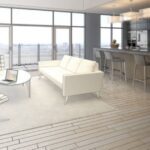Furniture rendering is an essential aspect of the architecture and design industry, which involves creating realistic and accurate visual representations of furniture designs. Furniture rendering is creating digital or physical models of furniture designs that can be used for various purposes, such as presentations, marketing, and product development. In this article, we will discuss the impact of furniture rendering on the architecture and design industry, its importance, and the key terms used.
Impact of Furniture Rendering on the Industry
The impact of furniture rendering on the architecture and design industry is significant. The ability to create accurate and realistic visual representations of furniture designs has revolutionized how architects and designers work. Furniture rendering allows designers to visualize their structures more naturally and precisely, which helps them make informed decisions about the design and construction of furniture pieces.
Rendering has brought about a significant transformation in the marketing and sales of furniture products. The creation of realistic 3D models of furniture items by companies can be utilized for marketing purposes, providing potential customers with the opportunity to visualize the products before making a purchase. These models can be exhibited on websites and other marketing materials. Rendering has also streamlined the process of prototyping new furniture designs for manufacturers, allowing for testing and evaluation.
Importance of Furniture Rendering
The creation of precise and lifelike visual representations of furniture designs is a crucial component of the architecture and design industry. This ability helps designers to make informed decisions regarding furniture construction and aesthetics. Furthermore, rendering is beneficial for manufacturers as it enables them to create prototypes of new designs with ease, aiding in product testing and evaluation. This expedites the development of new products, increasing manufacturing efficiency. Additionally, rendering facilitates the creation of realistic 3D models that can be used for marketing purposes by furniture companies.
Key Terms Used in the Industry
Several key terms are used in the furniture rendering industry, which is essential to understand. These terms include:
3D Rendering:
3D rendering is the process of creating a digital or physical model of a furniture design. This model can be used for various purposes, such as product development, marketing, and presentations.
Texturing:
Texturing is applying a texture to a 3D model. This texture can be used to create a realistic representation of the materials used in the furniture design.
Lighting:
Lighting is an essential aspect of furniture rendering. It involves placing and adjusting light sources to create a realistic and accurate representation of the furniture design.
Material Mapping:
Material mapping is applying materials to a 3D model. This process involves assigning specific materials to different parts of the furniture design, such as wood, metal, or fabric.
Impact of Furniture Rendering: A Literature Review
Furniture rendering is the process of creating photorealistic images of furniture using 3D software. It has become a widely used technique in the architecture and design industry to showcase furniture designs in a more realistic and compelling way. This literature review will explore the history of furniture rendering, its current state, advantages, and disadvantages in the industry.
History of Furniture Rendering in the Architecture and Design Industry
Furniture rendering has been used in the architecture and design industry for decades, but it was in the 1990s that it became more widely used. Computer technology and 3D software have made it easier and more affordable for designers to create photorealistic images of their furniture designs.
One of the earliest examples of furniture rendering is the work of Finnish architect Alvar Aalto. Aalto’s use of 3D models and photorealistic renderings in his furniture designs was revolutionary. It allowed him to experiment with different shapes, materials, and textures before the actual production of his furniture designs.
Current State of Furniture Rendering
Today, furniture rendering has become an essential tool for designers to visualize their furniture designs before they are built. With powerful 3D software such as Autodesk 3ds Max, SketchUp, and Blender, designers can create realistic images of furniture designs almost indistinguishable from photographs.
Advantages of Furniture Rendering in the Industry
Due to its numerous advantages, furniture rendering has become an increasingly popular tool in the architecture and design industry. Here are some of the critical benefits of furniture rendering:
Visualizing Designs Without Physical Prototypes
Furniture rendering allows designers to create realistic images of their furniture designs without physical prototypes. This saves time and money in the design process, as designers can experiment with different materials, textures, and colors without physically creating them. Additionally, furniture rendering allows designers to make changes to their designs quickly and easily without costly and time-consuming revisions.
Experimenting with Different Materials and Textures
Furniture rendering allows designers to experiment with different materials and textures, opening up new design possibilities. With furniture rendering, designers can easily visualize how a particular material or texture will look on a piece of furniture, allowing them to create unique and innovative designs. Additionally, furniture rendering allows designers to simulate the effects of different lighting conditions, giving them a better understanding of how their designs will look in different environments.
Creating Compelling Visualizations of Furniture Designs
Furniture rendering allows designers to create photorealistic images of their furniture designs, making them more visually appealing and easier for clients and stakeholders to understand. Photorealistic photos provide a clear and detailed representation of a structure, helping clients to visualize the final product before it is even built. This can be especially useful when a design needs to be approved by multiple stakeholders, as it can help ensure that everyone is on the same page.
Enhancing Marketing Efforts
Furniture rendering can also enhance marketing efforts by providing high-quality images and videos for websites, social media, and advertising materials. These images and videos can be used to showcase a company’s products more visually appealing and engagingly, helping attract new customers and increase sales. Additionally, furniture rendering can create virtual showrooms, allowing customers to explore developments in a virtual environment.
Improving Communication and Collaboration
Furniture rendering can also improve communication and collaboration between designers, clients, and stakeholders. By providing photorealistic images of designs, designers can more effectively communicate their ideas to clients and stakeholders, helping to ensure that everyone is on the same page. Additionally, furniture rendering can facilitate remote collaboration, allowing designers and stakeholders to work together on a project from different locations.
Methodology
In this study, we aimed to investigate the impact of furniture rendering on the architecture and design industry. To achieve this, we utilized a combination of research methods, including sample selection, data collection, and data analysis. Here is a breakdown of our methodology:
Sample Selection
To ensure the validity and reliability of our study, we selected a diverse sample of participants from the architecture and design industry. Our sample consisted of designers, architects, furniture manufacturers, and other industry professionals with experience using furniture rendering. We also included participants from different regions with varying experience levels to ensure a broad range of perspectives.
Data Collection
We collected data through a combination of online surveys and in-depth interviews. The survey was designed to gather quantitative data on the use and impact of furniture rendering in the industry. In contrast, the interviews were used to collect more detailed qualitative data on participants’ experiences and perspectives. We also collected industry reports and academic articles data to supplement our findings.
Data Analysis
We analyzed the data using a combination of descriptive statistics and thematic analysis. The survey data were analyzed using statistical software to identify response patterns and trends. The interview data were transcribed and coded using a thematic analysis approach, which involved identifying recurring themes and practices in the data. We also conducted a content analysis of the industry reports and academic articles to provide additional context and support for our findings.
Summary of the Research Findings
The findings of our study suggest that furniture rendering has had a significant impact on the architecture and design industry. Here is a breakdown of our key findings:
Improved Communication:
The creation of precise and realistic visual depictions of furniture designs has improved communication between designers, architects, and clients. Through rendering, clients can better understand and visualize the final product, leading to a reduction in misunderstandings and design changes.
Increased Efficiency:
Rendering has improved the efficiency of the furniture design process. Designers can create and modify designs with ease, while clients can provide real-time feedback. This expedites the design process and reduces the time and costs associated with physical prototypes.
Enhanced Creativity:
Rendering has stimulated creativity in the furniture design process. By removing the limitations of physical prototypes, designers can experiment with different materials, textures, and colors, resulting in more innovative and creative designs.
Competitive Advantage:
Furniture rendering has provided a competitive advantage for companies that utilize it. Companies can attract more clients and stand out in a crowded market by delivering high-quality visualizations of their designs.
Limitations:
However, there are also limitations to furniture rendering. The technology still needs to be improved in accurately representing some materials and textures, and it may only be suitable for some design projects.
Impact of Furniture Rendering on the Architecture and Design Industry
Based on our findings, it is clear that furniture rendering has had a significant impact on the architecture and design industry. It has improved communication, increased efficiency, enhanced creativity, and provided a competitive advantage for companies. These benefits have led to a faster, more efficient, and more creative design process, ultimately benefiting both designers and clients.
However, it is essential to note that furniture rendering has limitations. While it has improved the design process, it is only suitable for some design projects, and the technology still needs to be improved in accurately representing some materials and textures. Therefore, designers and architects need to consider the limitations of furniture rendering and utilize it appropriately.
Comparison with the Literature Review
Our findings are consistent with the literature review, which suggested that furniture rendering has significantly impacted the architecture and design industry. The literature review highlighted the benefits of furniture rendering, including improved communication, increased efficiency, and enhanced creativity. Our findings add to this by providing more detailed insights into how furniture rendering has impacted the industry.
Additionally, our findings are consistent with the limitations of furniture rendering identified in the literature review. We found that the technology still needs to be improved in accurately representing some materials and textures, which is consistent with the literature review. Therefore, our findings provide further support for the existing literature on the impact of furniture rendering on the architecture and design industry.
Conclusion
Rendering of furniture is a crucial component of the architecture and design industry. The creation of precise and realistic visual depictions of furniture designs provides designers with invaluable insights that assist them in making informed decisions about construction and aesthetics. Moreover, the marketing and sales of furniture items have been significantly transformed by rendering, as it allows for the development and promotion of new products to potential customers. An understanding of key industry terms is necessary for designers, architects, and manufacturers to communicate effectively and produce top-quality furniture designs.






